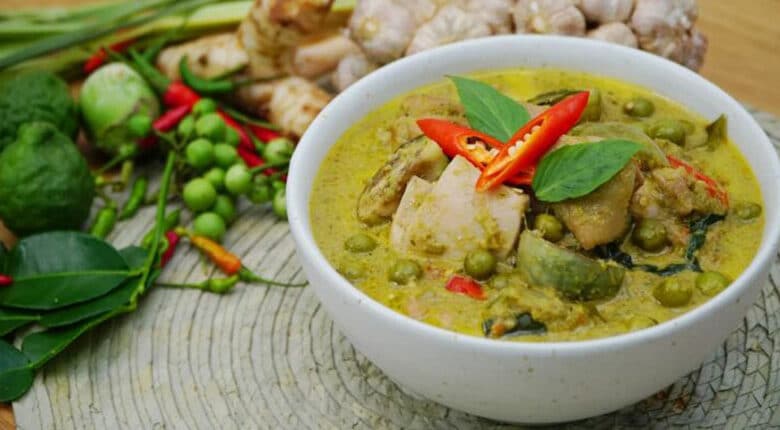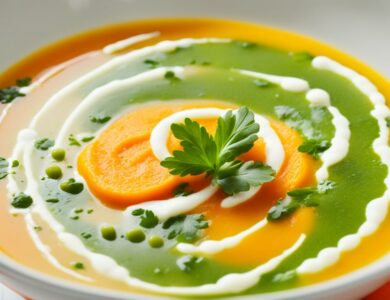
If you’re a fan of Thai cuisine, you’ve probably heard of the delicious and aromatic dish called Green Curry. Bursting with flavors and fragrant spices, Green Curry has become a popular choice for food enthusiasts all around the world. In this article, we will explore the origins, ingredients, and preparation of Green Curry, as well as provide you with a step-by-step recipe to create this mouthwatering dish at home.
Thai cuisine is renowned for its vibrant and aromatic flavors, and Green Curry is a prime example of this culinary excellence. This popular Thai dish is a creamy and spicy curry that combines a variety of fresh ingredients with the distinct flavors of Thai herbs and spices.
What is Green Curry?
Green Curry, also known as “Gaeng Keow Wan” in Thai, is a traditional Thai curry that originated from Central Thailand. It is named after its vibrant green color, which comes from the combination of green chili peppers, fresh herbs, and spices used in the curry paste. The curry is typically made with coconut milk, which gives it a rich and creamy texture.
Origins of Green Curry
Green Curry has its roots in the ancient Thai royal court. It was initially created as a special dish exclusively for the royal family due to its intricate preparation and the use of rare and exotic ingredients. Over time, Green Curry became more accessible to the general public and gained popularity as one of Thailand’s most beloved dishes.
Key Ingredients
To create the authentic flavors of Green Curry, several key ingredients are essential. These include:
- Green Curry Paste: Made from a blend of green chili peppers, shallots, garlic, lemongrass, galangal, coriander roots, and other aromatic herbs and spices, the Green Curry paste is the heart of this dish.
- Coconut Milk: This creamy ingredient adds richness to the curry and helps balance the spiciness of the green chili peppers.
- Protein: Green Curry can be prepared with various proteins, such as chicken, beef, shrimp, or tofu, depending on your preference.
- Vegetables: Common vegetables used in Green Curry include eggplant, bamboo shoots, bell peppers, and Thai basil.
- Fish Sauce: A staple ingredient in Thai cuisine, fish sauce adds a savory and umami flavor to the curry.
- Palm Sugar: Palm sugar provides a hint of sweetness to balance the spiciness and tanginess of the curry.
Making the Green Curry Paste
To make Green Curry, it is crucial to prepare a flavorful and aromatic green curry paste. Here’s a simple recipe to make the paste from scratch:
- Gather the ingredients for the green curry paste: green chili peppers, shallots, garlic, lemongrass, galangal, coriander roots, shrimp paste, and spices.
- In a mortar and pestle or a food processor, combine all the ingredients and grind them into a smooth paste. If using a mortar and pestle, start with the harder ingredients like galangal and lemongrass and gradually add the softer ones.
- Once the paste is well combined, you can store it in an airtight container in the refrigerator for future use. The homemade green curry paste will elevate the flavors of your dish.
Cooking Green Curry
Now that you have your green curry paste ready, it’s time to cook the Green Curry. Follow these steps to create a delicious and authentic Thai Green Curry:
- Heat a pan or wok over medium heat and add a tablespoon of oil. Once the oil is hot, add two to three tablespoons of the green curry paste and sauté for a minute until fragrant.
- Pour in one can of coconut milk and stir well to combine the paste with the coconut milk. Let it simmer for a few minutes to infuse the flavors.
- Add your choice of protein, such as sliced chicken, beef, shrimp, or tofu, to the pan. Stir-fry the protein until it’s cooked through.
- Next, add your preferred vegetables, such as sliced eggplant, bamboo shoots, bell peppers, and Thai basil. Cook for a few minutes until the vegetables are tender yet still retain their crispness.
- Season the curry with fish sauce and palm sugar to taste. Adjust the flavors according to your preference, adding more fish sauce for saltiness or palm sugar for sweetness.
- Allow the curry to simmer for a few more minutes, allowing the flavors to meld together. Keep stirring occasionally to prevent the coconut milk from separating.
- Once the curry has thickened slightly and the flavors have developed, remove it from the heat.
Serving and Pairing
Green Curry is typically served hot with steamed jasmine rice. The fragrant rice acts as a perfect accompaniment to balance the spiciness of the curry. You can also serve the curry with rice noodles or crusty bread if desired.
For a complete Thai dining experience, garnish your Green Curry with fresh Thai basil leaves, sliced red chili peppers, and a squeeze of lime juice. The basil leaves add a fresh herbal aroma, while the chili peppers and lime juice provide an extra kick of heat and tanginess.
To complement the flavors of Green Curry, you can pair it with a refreshing Thai iced tea or a cold beer. The creamy and spicy curry pairs well with the sweetness of Thai tea or the crispness of a cold brew.
Health Benefits of Green Curry
Apart from its delectable taste, Green Curry offers several health benefits:
- Rich in Antioxidants: The fresh herbs and spices used in Green Curry, such as lemongrass, galangal, and coriander, are packed with antioxidants that help combat free radicals in the body.
- Boosts Immunity: The combination of herbs and spices in Green Curry also provides immune-boosting properties, thanks to their antimicrobial and anti-inflammatory properties.
- Provides Essential Nutrients: Green Curry contains protein from the chosen protein source, along with vitamins and minerals from the vegetables, making it a wholesome and nutritious meal.
Variations of Green Curry
While the classic Green Curry recipe is incredibly delicious, there are also variations that you can explore:
- Vegetarian/Vegan Green Curry: Skip the animal protein and opt for tofu or a medley of vegetables as the main ingredient. Substitute fish sauce with soy sauce or tamari for a vegan version.
- Seafood Green Curry: Replace the traditional protein options with an assortment of seafood, such as shrimp, fish, or squid, to create a tantalizing seafood Green Curry.
- Green Curry with Noodles: Instead of serving Green Curry with rice, cook rice noodles separately and toss them in the curry for a delightfultwist on the traditional dish.
Tips and Tricks for Making the Perfect Green Curry
To ensure that your Green Curry turns out flavorful and authentic, consider the following tips and tricks:
- Use fresh ingredients whenever possible. The flavors of fresh herbs and spices will greatly enhance the taste of your curry.
- Adjust the spiciness level according to your preference. If you prefer a milder curry, reduce the amount of green chili peppers in the paste.
- Take care not to overcook the vegetables. They should be tender yet retain their vibrant colors and crunchiness.
- Experiment with different combinations of vegetables and proteins to create your own unique Green Curry recipe.
- If you’re short on time, you can use store-bought green curry paste. However, making it from scratch will yield the best results.
- Taste and adjust the seasoning as you go. Thai cuisine is all about achieving a balance of flavors, so trust your palate and make necessary adjustments.
Conclusion
Green Curry is a must-try Thai dish that will tantalize your taste buds with its vibrant flavors and aromatic spices. Whether you’re a fan of spicy food or simply looking to explore the diverse world of Thai cuisine, Green Curry is a perfect choice. By following the step-by-step recipe and incorporating fresh ingredients, you can create a homemade Green Curry that rivals those served in Thai restaurants. So, gather your ingredients, unleash your culinary creativity, and savor the mouthwatering flavors of Green Curry.
Frequently Asked Questions (FAQs)
- Is Green Curry spicy? Green Curry is known for its spiciness, but you can adjust the level of heat by reducing the amount of green chili peppers in the paste.
- Can I freeze Green Curry? Yes, you can freeze Green Curry. Store it in an airtight container and consume it within three months for the best quality.
- What can I substitute for fish sauce in Green Curry? If you prefer a vegetarian or vegan version, you can substitute fish sauce with soy sauce or tamari.
- Can I use different types of meat in Green Curry? Absolutely! Green Curry is versatile, and you can use chicken, beef, pork, or even seafood as the protein component.
- How long does it take to make Green Curry? From preparation to serving, it usually takes about 45 minutes to an hour to make Green Curry.



